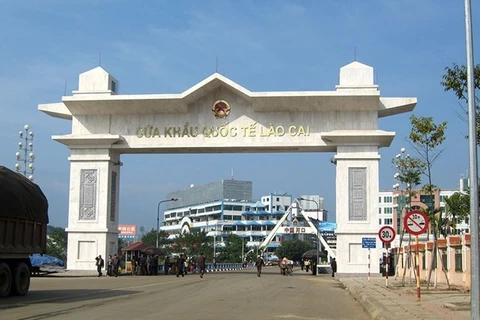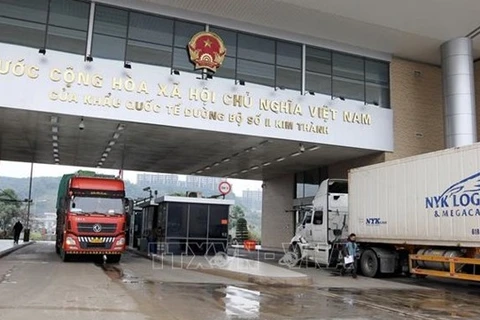Hanoi (VNA) – A meeting held by the Ministry of Agriculture and Rural Development (MARD) on March 9 pointed out the urgent need to shift from unofficial and small-scale shipment to export through official channels to China.
Minister Le Minh Hoan stressed that shifting from unofficial to official export is a revolution needing persistence, willingness, and readiness of the entire production and trading systems.
Nguyen Quoc Toan, Director of the MARD’s Agro Processing and Market Development Authority, said China, one of the largest importers of Vietnamese products, is tightening control over the commodities not exported via official channels. Given this, some agricultural products of Vietnam like durian and passion fruit, which have long been shipped through border crossings by border residents, are now unable to enter this market.
Director of the Huy Long An Co. Ltd Vo Quan Huy pointed out that China has been standardising imports, but Vietnamese businesses seem to be not ready yet.
Though Vietnam possesses many products in demand in China, to successfully export to this market, enterprises need to improve their business measures to meet the importer’s requirements, he noted.
Dinh Cao Khue, Chairman of the Dong Giao Foodstuff Export JSC (DOVECO), underlined the need to shift to official export as soon as possible since every trading issue will become transparent at that time.
He called on the MARD to coordinate with the Ministry of Home Affairs to consolidate business associations as some of them are working ineffectively and haven’t grasped market information.
Meanwhile, Vice Secretary General of the Vietnam Association of Seafood Exporters and Producers (VASEP) Nguyen Hoai Nam noted China is a large market with strict requirements, so the management of export quality should be systematic like the way Vietnam is exporting goods to such markets as the EU and Japan.
He also recommended the sectors be involved and the role of ministries, businesses, and localities be identified so as to help companies access information.
Besides, it is necessary to invest more in farm produce preservation, and the State should issue favourable land and capital policies to attract investment to this field, Nam added.
Agro-forestry-fishery trade between Vietnam and China reached 12.6 billion USD in 2021, up 18.39 percent year on year. It stood at over 1.83 billion USD in the first two months of 2022, down 1.7 percent, including 1.3 billion USD in Vietnam’s exports (down 7.4 percent) and 515 million USD in imports from China (up 16.6 percent), according to the MARD./.
Minister Le Minh Hoan stressed that shifting from unofficial to official export is a revolution needing persistence, willingness, and readiness of the entire production and trading systems.
Nguyen Quoc Toan, Director of the MARD’s Agro Processing and Market Development Authority, said China, one of the largest importers of Vietnamese products, is tightening control over the commodities not exported via official channels. Given this, some agricultural products of Vietnam like durian and passion fruit, which have long been shipped through border crossings by border residents, are now unable to enter this market.
Director of the Huy Long An Co. Ltd Vo Quan Huy pointed out that China has been standardising imports, but Vietnamese businesses seem to be not ready yet.
Though Vietnam possesses many products in demand in China, to successfully export to this market, enterprises need to improve their business measures to meet the importer’s requirements, he noted.
Dinh Cao Khue, Chairman of the Dong Giao Foodstuff Export JSC (DOVECO), underlined the need to shift to official export as soon as possible since every trading issue will become transparent at that time.
He called on the MARD to coordinate with the Ministry of Home Affairs to consolidate business associations as some of them are working ineffectively and haven’t grasped market information.
Meanwhile, Vice Secretary General of the Vietnam Association of Seafood Exporters and Producers (VASEP) Nguyen Hoai Nam noted China is a large market with strict requirements, so the management of export quality should be systematic like the way Vietnam is exporting goods to such markets as the EU and Japan.
He also recommended the sectors be involved and the role of ministries, businesses, and localities be identified so as to help companies access information.
Besides, it is necessary to invest more in farm produce preservation, and the State should issue favourable land and capital policies to attract investment to this field, Nam added.
Agro-forestry-fishery trade between Vietnam and China reached 12.6 billion USD in 2021, up 18.39 percent year on year. It stood at over 1.83 billion USD in the first two months of 2022, down 1.7 percent, including 1.3 billion USD in Vietnam’s exports (down 7.4 percent) and 515 million USD in imports from China (up 16.6 percent), according to the MARD./.
VNA

























